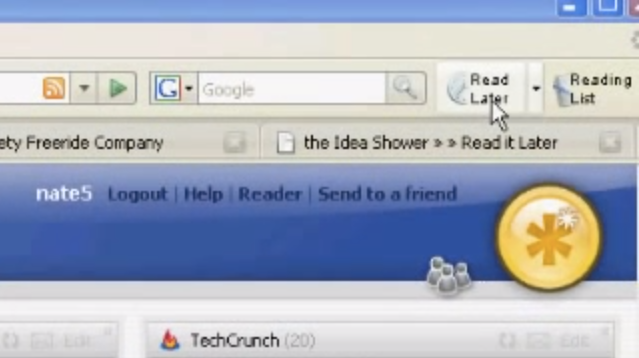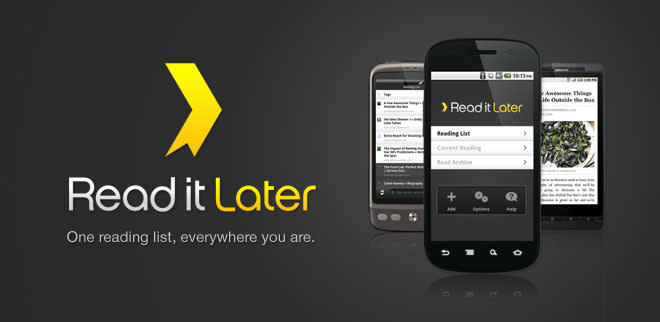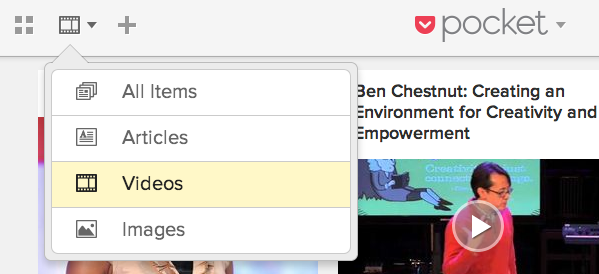Pocket promises to help you do one thing: "save for later."
Built around this simple offering, the app—one of a half-dozen of its kind—has attracted more than 11 million users who have collectively saved over 950 million items.
So how has Pocket, originally released as Read It Later in 2007, pulled this off? The answer you’ll hear from Nate Weiner, the app's humble creator, is by simply staying true to its promise. In Pocket, for example, there's no "trending now" feature or "most saved by others" reading list. It's only the items saved by the user.
"Unlike pretty much every other service, we’ve avoided doing discovery—recommendation of new articles—because for most of the people that are using this product today, the issue is not so much too little content on the Internet," Weiner says. "It’s a matter of how are you using this tool to help you get through all of the content on the Internet."

With 13 team members, more than $7 million in funding and a high user retention rate, there’s plenty of distractions that could pop up in Pocket’s path.
In a phone interview last week, Weiner told us the process his team uses to decide new features and revealed the one aspect of the app they obsess over—messing it up, they learned, reduces the number of saves by 3x. He also shared how their rebrand in April 2012 doubled the app’s user base in a matter of months, how he uses Pocket personally and why Trello is his new favorite productivity tool.
Interviewee answers edited for length.
How Pocket Came To Be
Zapier: As the founder, how do you describe Pocket?
Nate Weiner: Pocket is the best place to save and view content. It’s the solution to if you’re the type of person who’s always emailing themselves links or keeping a billion tabs open in a browser, Pocket allows you to save all that content to one place that you can view no matter when and where you are.
What’s the story behind Pocket?
What I just described was a problem that I had. I was working at a web design firm in Minneapolis about six-and-a-half years ago and during the course of the day I was coming across stuff all the time that I wanted to save, whether it be an article or a tutorial on something or a video I want to watch, and I was just emailing myself all these links. I would never open any of them because they would clutter up my inbox.
So one night I sat down and I built a Firefox extension—I wanted to learn how to make Firefox extensions and it was the one thing I wanted to fix. I took two nights, built the Firefox extension (below), and it was just this basic place to save a list that stayed in your browser of just stuff you wanted to save for later. After you opened that thing, you could remove it, never see it again, or you could share it out to a bunch of different places. That was the basic notion.

It was initially very much just scratching your own itch, so to speak, but in terms of its growth, it was one of those things where I certainly had no idea of what the impact would have been at the time. Once it got picked up on Lifehacker and then a number of other sites, it exploded from there. It quickly became very apparent to me that there were a lot of other people that had this problem.
When you reflect on Pocket’s early days, is there anything, such as the literal app name, to which you say, "I’m sure glad I did that, because that’s what helped this thing take off"?
The thing that I feel like that made it take off was keeping really true to that name and keeping really true to that initial idea of keeping it simple. If you look at what Pocket is compared to (similar apps), the single biggest difference has been our focus to stay true to that original vision: it’s always been about ‘save for later.’ It’s always been about saving content, making that as easy as possible.
You’ll see that we are on a hellbent tour to reduce the number of steps it takes to save—our extensions have always been one click. They’ve never been like, ‘Open this thing, and then pick where you want to put it.’ It’s always just ‘Click it, and you’re done.’ Every mobile app that Pocket is integrated into we tirelessly work with them to reduce the number of taps. We've seen that every tap you add reduces the number of saves by 3x.

On the other side of it, we've always been tied to the notion of making sure you can view this content no matter where you are. We’ve tried to expand to every major platform that we can, and we support every type of content. This has probably been one of the biggest differences between us and other products. It’s not just about reading—articles only make up about 60 percent of all that’s saved to Pocket.
Pocket’s homepage touts two numbers: 11 million users and 850 million* items saved. When I say those out loud, what’s your reaction, especially considering this app started as a side project?
It’s pretty remarkable to see that. I remember in the college era reading some article about Digg, which was big at the time, and I remember it saying they had a million users and I thought, ‘Man, how cool would that be if you had something that a million people were using.’ That was always the thing that I was trying to hit, so hitting something that 11 million people have interacted with, used or checked out is pretty mind-blowing to that degree. […]
When we crossed the 10 million mark, it was a pretty awesome number, but at the same time we really are looking more towards the future. Every user that signs up is always like, ‘Hey, I can’t believe I’ve never heard of this.’ That’s our biggest challenge to date. How do we get out there? How do we raise awareness? It’s not fighting over a market share like a browser would be, it’s really just trying to get people to realize that there’s a better solution for how to do this.
For us, 11 million is a big number but we know the potential is a lot more.
*Though its website today reads "850 million," Pocket users have now saved 950 million items, according to the company.
Marketing Read It Later Pocket

Do you put much of your budget behind marketing or advertising?
In terms of advertising, no. We haven’t done anything there to date. Paid advertising is a bit hard if you don’t have a monetized product behind it, because otherwise you’re just throwing money out there.
One of the biggest challenges I had as a product-slash-entrepreneur person is really understanding the value of marketing. […] The rebrand to Pocket was one of the first times that we really started thinking about the importance of marketing and specifically about the messaging. How are you telling your story? What does your story mean? What does your product mean? You can see since the evolution of Read It Later to Pocket and moving forward, we spend a lot more time trying to think about how our users perceive Pocket and how the market perceives Pocket, because we want to have a really strong brand. We want to have a really strong product that people care about, share and talk about.
It sounds safe to say that the rebrand overall was a very positive thing for Read It Later.
Yes, we doubled our user base inside of a few months (going from 4 to 8 million users). The rebrand was as successful as I think it could be and I think it’s because we had a good story, we had a good product vision and it was really just about refining that and getting back to the roots. If you look at the difference between Read It Later and Pocket, you'll actually see that we simplified it a lot more, there were a few areas we removed. There’s things that we did add, but it was all about honing in more on the core idea of what Pocket is supposed to be.

Process and Productivity at Pocket HQ
What’s the process at Pocket to decide the next feature or product update?
When we think about product, we try to think about the problems (a new feature would be) solving. For example, you may get a lot of suggestions from users such as, ‘Hey, we want tagging or folders to be able to organize our stuff.’ The first step of our process is to try and understand the actual problem (behind it).
Around the Pocket rebrand, some of the questions we were getting asked (were) around folders. The most common reason that people were doing that was, ‘Oh, I want to be able to separate out my videos.’ For us, when we looked at it we’re like, ‘Oh, we actually could do that way better because we can detect stuff as videos, we could just automatically create a video section for you, rather than forcing everybody to create their own video folder and manually move stuff there. That’s the process that we look at.’

In terms of our design process, it’s very much the same thing. We sit down to look at how to implement a feature or how to tune things. We try to always pose things as questions or problems to be solved—we try to move away from opinion and try to be as objective as possible. If we have a question, we ask, ‘How can we actually validate this?’
How do you use Pocket?
For the most part, what I save to Pocket is stuff that I feel like is going to help me grow, you know, learn from. There's a lot I save about business, a lot I save about tech and design. It's just one of those things where I can take 30 minutes on a bus ride and just blow through a number of articles I've saved to Pocket. I feel like I always come away with some new insight or way of thinking about something. That (feeling can be) hard to capture from just blowing through a billion articles on Twitter.
Outside of using Pocket, what's one productivity practice you follow in your own life?
Previously, anytime I came up with a task or something I needed to do, I emailed that to myself. I guess it’s similar to the story of Read It Later—(I realized) email is just a terrible place to put tasks. […] I’d been experimenting with a lot of to-do lists, whether it was a notepad or an actual to-do app, and none of them really worked for me.
The thing that’s actually stuck recently, which I’ve been amazed by because I’ve never had a to-do list type thing stick, is I’ve started using Trello. I just love the way they do the boards. I have a board that I call The Hopper, and I have a board that’s Today, Tomorrow and This Week.
Monday: It’s 4pm and my Trello board is still scrollable.
— Nate Weiner (@NateWeiner) February 25, 2014
So anytime I come up with something, I just hop into the app, drop it in The Hopper and then at the beginning and end of the day, I can recycle these things and move them around as need be. It’s amazing because I’m actually keeping track of all this stuff—it’s been totally a game changer for me. It also keeps my email less cluttered with things to do, which was always hard. Now when I just buzz through my email it can be about things I have to respond to instead of tasks.
In your Pocket account, how many items have you saved?
Oh boy, I actually (need to) hit the database for that because the apps don’t even allow me to load that many. … The app caps it out at 5,000. … It’s 14,000 (since 2007).
Credits: Images courtesy Pocket.
You might also like this interview: "From 0 to 100,000 Users in 4 Months: The Story Behind Productivity Chrome Extension Momentum"





